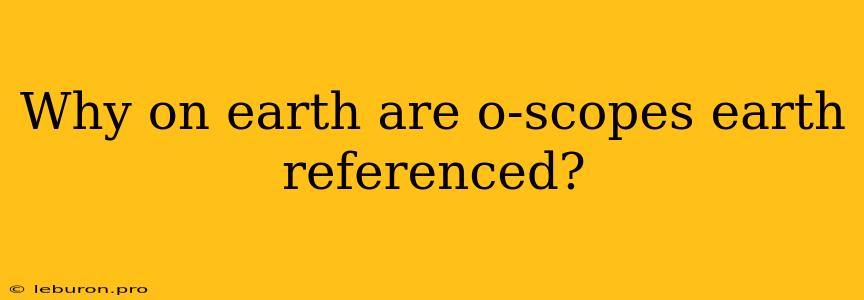Why on Earth are O-Scopes Earth Referenced?
The concept of the zodiac, a celestial circle divided into twelve segments, has been a fundamental part of astrology for centuries. Each segment corresponds to a specific constellation and is associated with particular personality traits, strengths, and weaknesses. While the constellations themselves are undeniably part of the vast celestial expanse, the zodiac's unique connection to Earth's perspective might seem odd at first glance. Why are o-scopes, or horoscopes, Earth-referenced, tied to our planet's rotation and seasons? The answer lies in the intertwined history of astrology and astronomy, a fascinating journey of observation and interpretation that ultimately connects our lives to the cosmos.
The Birth of the Zodiac: A Celestial Map for Humanity
The earliest known records of the zodiac date back to ancient Mesopotamia, where astronomers meticulously charted the movements of the celestial bodies. As they observed the apparent path of the Sun across the sky throughout the year, they noticed that the Sun's position against the backdrop of stars shifted, aligning with specific constellations at different times. These constellations became markers for the seasons, influencing agricultural practices and cultural beliefs.
The Babylonians, known for their sophisticated mathematical and astronomical knowledge, developed a system of twelve constellations, each representing a month of the year. This system eventually evolved into the zodiac we know today, with each constellation associated with specific personality traits and characteristics based on its perceived influence on human behavior.
H3: The Earth's Perspective: A Crucial Factor
The zodiac's earth-referenced nature stems from the fact that it's based on our planet's perspective. From Earth, we observe the Sun's apparent movement against the backdrop of the fixed stars, and this movement aligns with different constellations at different times of the year. This phenomenon, known as the "ecliptic," is the path the Sun appears to take across the sky as Earth orbits around it. The zodiac is a projection of the ecliptic onto the celestial sphere, effectively creating a celestial map for Earth's seasons and its influence on human life.
The Earth's Role in Defining Zodiac Traits
The zodiac's connection to Earth extends beyond simply marking seasons. The constellations, while physically distant, are seen as exerting an influence on people born under their corresponding periods. Each constellation, according to astrologers, possesses unique qualities and energies that shape the personality and life path of individuals born during its ruling period.
H3: The Sun's Position and the Zodiac Signs
The Sun's position in the sky at the time of a person's birth determines their zodiac sign. Each sign is governed by the constellation the Sun appears to be in from Earth's perspective at that specific moment. This association, while astrological in nature, is deeply intertwined with Earth's position in its orbit around the Sun.
H3: Seasonal Influences and Zodiac Traits
The zodiac's Earth-reference further manifests in the correlation between signs and the seasons they govern. For instance, Aries, the first sign, is associated with spring, symbolizing new beginnings and energy. This reflects the earth's renewal as the spring season arrives. Similarly, Cancer, a water sign, is associated with summer, representing emotion and nurture, mirroring the abundant and nurturing nature of the season. This intricate connection between the Earth's cycles and the zodiac's symbolism reinforces the idea that the zodiac's framework is intrinsically linked to our planet's experience.
The Zodiac: Beyond Earth's Boundaries
While the zodiac is undeniably Earth-referenced, its influence extends beyond our planet's boundaries. It serves as a framework for understanding human nature and its connection to the cosmos. Astrologers argue that the zodiac represents a cosmic dance of energies, with each sign representing a unique vibration within this grand orchestra.
A Continued Exploration: The Zodiac and the Earth's Perspective
The zodiac's Earth-reference serves as a fascinating reminder of our interconnectedness with the universe. It highlights the role of our planet's position in shaping our understanding of the cosmos and its influence on our lives. The zodiac, with its rich history and profound symbolism, continues to intrigue and inspire, encouraging us to explore the intricate web of connections that bind us to the celestial realm.
